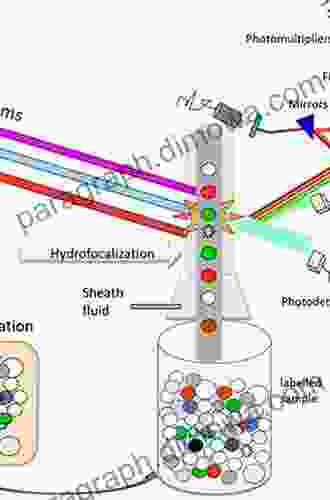Scanning Transmission Electron Microscopy of Nanomaterials: A Voyage into the Atomic Realm

In the realm of materials science, the ability to probe and understand the structure and composition of materials at the atomic level is crucial. This ability has paved the way for groundbreaking discoveries and technological advancements, particularly in the field of nanomaterials. Nanomaterials, with their unique properties and potential applications, have sparked immense interest in understanding their properties at the nanoscale.
4.5 out of 5
| Language | : | English |
| File size | : | 30542 KB |
| Text-to-Speech | : | Enabled |
| Enhanced typesetting | : | Enabled |
| Print length | : | 616 pages |
| Screen Reader | : | Supported |
Scanning Transmission Electron Microscopy (STEM) has emerged as an indispensable tool for unraveling the atomic-scale details of nanomaterials. This powerful microscopy technique combines the principles of scanning transmission electron microscopy and transmission electron microscopy to provide unparalleled resolution and analytical capabilities.
Principles of STEM
STEM operates on the principle of scanning a finely focused electron beam across a thin sample of the material. The electron beam interacts with the atoms in the sample, generating various signals that carry information about the atomic structure, composition, and electronic properties of the material.
The transmitted electrons, which pass through the sample, are used to form an image of the sample. The intensity of the transmitted electrons varies depending on the atomic number and thickness of the material, providing information about the atomic structure and composition.
High-Resolution Imaging with STEM
One of the most remarkable capabilities of STEM is its ability to produce high-resolution images of materials at the atomic level. By finely focusing the electron beam to a sub-angstrom resolution, STEM can resolve individual atoms and reveal the atomic arrangements within the material.
These high-resolution images provide invaluable insights into the crystal structure, defects, and atomic-scale morphology of nanomaterials. They enable researchers to visualize the atomic arrangements, identify defects, and study the relationships between atomic structure and properties.
Analytical Capabilities of STEM
Beyond imaging, STEM also offers a range of analytical capabilities that provide detailed information about the elemental composition and electronic properties of nanomaterials.
- Energy-Dispersive X-ray Spectroscopy (EDS): EDS analyzes the characteristic X-rays emitted by the sample when it is struck by the electron beam. This technique provides quantitative information about the elemental composition of the material.
- Electron Energy Loss Spectroscopy (EELS): EELS measures the energy loss of electrons that have interacted with the sample. EELS provides information about the electronic structure, bonding, and chemical states of the material.
- Cathodoluminescence (CL): CL detects the light emitted by the sample when it is excited by the electron beam. CL provides information about the optical properties and electronic transitions within the material.
Applications of STEM in Nanomaterials
The versatility of STEM makes it a powerful tool for a wide range of applications in nanomaterials research. Some of the key applications include:
- Characterization of nanomaterial structure: STEM is used to determine the crystal structure, size, shape, and morphology of nanomaterials.
- Identification of defects and interfaces: STEM can reveal defects such as dislocations, grain boundaries, and stacking faults, as well as interfaces between different materials.
- Analysis of elemental composition and distribution: STEM provides detailed information about the elemental composition and distribution within nanomaterials.
- Investigation of electronic properties: STEM can probe the electronic structure, bandgap, and charge distribution within nanomaterials.
- Development of nanodevices: STEM is used to characterize and optimize the performance of nanodevices, such as transistors, solar cells, and sensors.
Scanning Transmission Electron Microscopy has revolutionized the field of nanomaterials research by providing unparalleled insights into the atomic-scale structure and properties of these materials. With its ability to produce high-resolution images and perform in-depth analysis, STEM has become an indispensable tool for understanding the behavior of nanomaterials and developing novel nanotechnologies.
As the field of nanotechnology continues to advance, STEM will undoubtedly play a pivotal role in shaping the future of materials science and technology. Its ability to unravel the atomic world of nanomaterials holds the key to unlocking new discoveries and creating innovative materials with unprecedented properties.
4.5 out of 5
| Language | : | English |
| File size | : | 30542 KB |
| Text-to-Speech | : | Enabled |
| Enhanced typesetting | : | Enabled |
| Print length | : | 616 pages |
| Screen Reader | : | Supported |
Do you want to contribute by writing guest posts on this blog?
Please contact us and send us a resume of previous articles that you have written.
 Book
Book Novel
Novel Page
Page Chapter
Chapter Text
Text Story
Story Genre
Genre Reader
Reader Library
Library Paperback
Paperback E-book
E-book Magazine
Magazine Newspaper
Newspaper Paragraph
Paragraph Sentence
Sentence Bookmark
Bookmark Shelf
Shelf Glossary
Glossary Bibliography
Bibliography Foreword
Foreword Preface
Preface Synopsis
Synopsis Annotation
Annotation Footnote
Footnote Manuscript
Manuscript Scroll
Scroll Codex
Codex Tome
Tome Bestseller
Bestseller Classics
Classics Library card
Library card Narrative
Narrative Biography
Biography Autobiography
Autobiography Memoir
Memoir Reference
Reference Encyclopedia
Encyclopedia Kenny Kings
Kenny Kings James P Ignizio
James P Ignizio J M Porup
J M Porup J K Rowling
J K Rowling Nora Shalaway Carpenter
Nora Shalaway Carpenter Ramesh Singh
Ramesh Singh Ruth Bernstein
Ruth Bernstein Jack Kelly
Jack Kelly Jackie Bolen
Jackie Bolen Pamela Gayle
Pamela Gayle Jan Hayes
Jan Hayes Langley Gray
Langley Gray Jami Borek
Jami Borek Jerry L Harbour
Jerry L Harbour Jake Coburn
Jake Coburn Jacques Franchino
Jacques Franchino Robert S Lyons
Robert S Lyons Murray R Spiegel
Murray R Spiegel Maxwell Anderson
Maxwell Anderson James Laurence
James Laurence
Light bulbAdvertise smarter! Our strategic ad space ensures maximum exposure. Reserve your spot today!
 Finn CoxFollow ·5.6k
Finn CoxFollow ·5.6k Jason ReedFollow ·6.6k
Jason ReedFollow ·6.6k Junot DíazFollow ·4.1k
Junot DíazFollow ·4.1k John GrishamFollow ·14.2k
John GrishamFollow ·14.2k Francis TurnerFollow ·13.1k
Francis TurnerFollow ·13.1k Russell MitchellFollow ·14.9k
Russell MitchellFollow ·14.9k Robert Louis StevensonFollow ·3.6k
Robert Louis StevensonFollow ·3.6k Fernando BellFollow ·9.7k
Fernando BellFollow ·9.7k

 William Golding
William GoldingWhere Dreams Descend: A Literary Gateway to a Kingdom of...
Prepare yourself for a...

 Joseph Conrad
Joseph ConradAmy Tan: Asian Americans of Achievement
Amy Tan is an...

 Fredrick Cox
Fredrick CoxAn Acorn Frog and Dog: An Unforgettable Adventure for...
Embark on an enchanting journey with "An...

 Robert Reed
Robert ReedAnna Sui: An Inspiring Asian American Role Model
Anna Sui is a...

 Jeremy Cook
Jeremy CookGrowing Up in Slavery: An Unforgettable and Harrowing...
A Window into a Forgotten...
4.5 out of 5
| Language | : | English |
| File size | : | 30542 KB |
| Text-to-Speech | : | Enabled |
| Enhanced typesetting | : | Enabled |
| Print length | : | 616 pages |
| Screen Reader | : | Supported |














